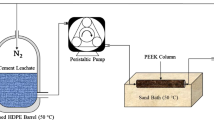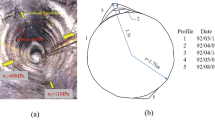Abstract
In this paper, a comparative modelling exercise from the DECOVALEX-2015 project is presented. The exercise is based on in situ experiments, performed at the Tournemire Underground Research Laboratory (URL), run by the IRSN (Institut de Radioprotection et de Sûreté Nucléaire), in France. These experiments aim at identifying conditions (e.g. technical specifications, design, construction, and defects) that will affect the long-term performance of swelling clay-based sealing systems, which is of key importance for the safety of underground nuclear waste disposal facilities. A number of materials are being considered as seals; the current work focusses on a 70/30 MX80 bentonite–sand mixture initially compacted at a dry density of 1.94 Mg/m3. The performance of the sealing plug involves at least three different important components, which are the hydro-mechanical behaviour of the bentonite–sand core, the overall permeability of the surrounding argillite, and the influence of the technological gap between the core and the argillite. Two particular tests have been selected for a comparative modelling exercise: the WT-1 test, which was designed to study the rock mass permeability, and the PT-A1 test, which aimed at quantifying the evolution of the hydro-mechanical field within the bentonite–sand core. A number of independent teams have worked towards modelling these experiments, using different codes and input parameters calibrated on additional small-scale laboratory experiments. Their results are compared and discussed.





















Similar content being viewed by others
References
Alonso EE, Gens A, Josa A (1990) A constitutive model for partially saturated soils. Géotechnique 40(3):405–430
Arnold BW, Brady PV, Bauer SJ, Herrick C, Pyen S, Finger J (2011) Reference design and operations for deep borehole disposal of high-level radioactive waste. SAND2011-6749, Sandia National Laboratories. Albuquerque, NM
Barnichon JD, Deleruyelle F (2009) Sealing experiments at the Tournemire URL: the SEALEX Project. Eurosafe
Barnichon JD, Dick P, Bauer C (2011) The SEALEX in situ experiments: performance tests of repository seals. In: Harmonising Rock Engineering and the Environment—Qian & Zhou (eds) © 2012 Taylor & Francis Group, London, ISBN 978-0-415-80444-8, pp. 1391–1394
Baumgartner P (2006) Generic thermal-mechanical-hydraulic (THM) data for sealing materials. Volume 1: soil—water relationships. Report No: 06819-REP-01300-10122-R00. Atomic Energy of Canada Limited
Boisson JY, Bertrand L, Heitz JF, Moreau-Le Golvan Y (2001) In situ and laboratory investigations of fluid flow through an argillaceous formation at different scales of space and time, Tournemire tunnel, southern France. Hydrogeol J 9:108–123
Bond AE, Benbow SJ (2009) QPAC multi-phase flow module functional specification and architectural design. Quintessa Report QRS-QPAC-HYD-2 v1.0
COMSOL 2012 The COMSOL Multiphysics User’s Guide, ver. 4.3a
Daupley X (1997) Etude du potentiel de l’eau interstitielle d’une roche argileuse et de relations entre ses propriétés hydriques et mécaniques, Doctoral thesis, ENSMP Paris (in French)
Dixon DA, Priyanto DG, Martino JB, De Combarieu M, Johansson R, Korkeakoski P, Villagran J (2014) Enhances Sealing Project (ESP): evolution of a full-sized bentonite and concrete shaft seal. vol 400(1). Geological Society, London, Special Publications, pp 63–70. doi:10.1144/SP400.33
Dueck A (2004) Hydro-mechanical properties of a water unsaturated sodium bentonite, laboratory study and theoretical interpretation, Doctoral thesis ISBN 91-973723-6-6
Huertas F, Fuentes-Santillana JL, Jullien F, Rivas P, Linares J, Fariña P, Ghoreychi M, Jockwer N, Kickmaier W, Martínez MA, Samper J, Alonso E, Elorza FJ (2000) Full-scale engineered barriers experiment for a deep geological repository for high-level radioactive waste in crystalline host rock. EC Final REPORT EUR 19147
Kolditz O, Bauer S, Bilke L, Böttcher N, Delfs JO, Fischer T, Park CH (2012) OpenGeoSys: an open-source initiative for numerical simulation of thermo-hydro-mechanical/chemical (THM/C) processes in porous media. Environ Earth Sci 67(2):589–599
Man A, Martino JB (2009) Thermal, hydraulic and mechanical properties of sealing materials. NWMO TR-2009-20. Toronto, Canada: Nuclear Waste Management Organization
Martino JB, Dixon D, Stroes-Gascoyne S, Guo R, Kozak ET, Gascoyne M, Fujita T, Vignal B, Sugita Y, Masumoto K, Saskura T, Bourbon X, Gingras-Genois 1., Collins D (2008) The tunnel sealing experiment: 10 year summary. Atomic Energy of Canada Ltd., URL-12150-REPT-001, Chalk River
Millard A, Mokni N, Barnichon JD, Thatcher KE, Bond AE, Fraser-Harris A, Mc Dermott C, Blaheta R, Michalec Z, Hasal M, Nguyen TS, Nasir O, Fedors R, Yi H, Kolditz O (2016) Comparative modelling of laboratory experiments for the hydro-mechanical behavior of a compacted bentonite-sand mixture. Environ Earth Sci. doi:10.1007/s12665-016-6118-z
Navarro V, Asensio L, De la Morena G, Pintado X, Yustres Á (2015) Differentiated intra- and inter-aggregate water content models of mx-80 bentonite. Appl Clay Sci 118:325–336
Olivella S, Carrera J, Gens A, Alonso EE (1994) Non isothermal multiphase flow of brine and gas through saline media. Transport Porous Media 15:271–293
Olivella S, Gens A, Carrera J, Alonso EE (1995) Numerical formulation for a simulator (CODE_BRIGHT) for the coupled analysis of saline media. Eng Comput 13:87–112
Pusch R, Karnland O, Hökmark H (1990) GMM—a general microstructural model for qualitative and quantitative studies of smectite clays. SKB Technical Report 90-43, Stockholm, Sweden
Quintessa (2013) QPAC: Quintessa’s General-Purpose Model-ling Software QRS-QPAC-11. http://www.quintessa.org/qpac-overview-report.pdf
Rejeb A, Tijani M (2003) Champs de contrainte dans les argilites de Tournemire. Mesures in situ et interprétation, Revue Française de Géotechnique 103:75–84
Richards LA (1931) Capillary conduction of liquids through porous mediums. J Appl Phys 1(5):318–333
Saba S (2014) Comportement hydromécanique différé des barrières ouvragées argileuses gonflantes, PhD Thesis, Université Paris Est, France (in French)
Thatcher KE, Bond AE (2016) Evidence for the evolution of excavation damage zone hydraulic properties from the SEALEX experiment. Environmental Earth Sciences, submitted
Thatcher KE, Bond AE, Robinson P, McDermott C, Fraser Harris AP, Norris S (2016) A new hydro-mechanical model for bentonite resaturation applied to the SEALEX experiments. Environ Earth Sci. doi:10.1007/s12665-016-5741-z
Valès F, Nguyen Minh D, Gharbi H, Rejeb A (2004) Experimental study of the influence of the degree of saturation on physical and mechanical properties in Tournemire shale (France). Appl Clay Sci 26:197–207
van Geet M, Bastiaens W, Volckaert G, Weetjens E, Sillen X, Gens A, Villar MV, Imbert C, Filippi M, Plas F (2007) Installation and evaluation of a large-scale in-situ shaft seal experiment in Boom clay—The RESEAL project. International conference on clays in natural and engineered barriers for radioactive waste confinement, Lille, France
van Genuchten MTh (1980) A closed-form equation for predicting the hydraulic conductivity of unsaturated soils. Soil Sci Soc America 44(5):892–898
Villar MV, Campos R, Gutiérrez-Nebot L (2014) EB experiment Laboratory post-mortem analyses report CIEMAT Technical Report CIEMAT/DMA/2G210/01/2014
Wang Q, Tang AM, Cui YJ, Delage P, Gatmiri B (2012) Experimental study on the swelling behaviour of bentonite/claystone mixture. Eng Geol 124:59–66
Wang Q, Tang AM, Cui YJ, Barnichon JD, Saba S, Ye WM (2013a) Hydraulic conductivity and microstructure changes of compacted bentonite/sand mixture during hydration. Eng Geol 164:67–76
Wang Q, Tang AM, Cui YJ, Delage P, Barnichon JD, Ye WM (2013b) The effects of technological voids on the hydro-mechanical behaviour of compacted bentonite-sand mixture. Soils Found 53(2):232–245
Acknowledgements
The work described in this paper was conducted within the context of the international DECOVALEX Project. The authors are grateful to the Funding Organisations who supported the work. The views expressed in the paper are, however, those of the authors and are not necessarily those of the Funding Organisations.
Author information
Authors and Affiliations
Corresponding author
Additional information
This article is part of a Topical Collection in Environmental Earth Sciences on “DECOVALEX 2015”, guest edited by Jens T Birkholzer, Alexander E Bond, John A Hudson, Lanru Jing, Hua Shao and Olaf Kolditz.
Rights and permissions
About this article
Cite this article
Millard, A., Mokni, N., Barnichon, J.D. et al. Comparative modelling approaches of hydro-mechanical processes in sealing experiments at the Tournemire URL. Environ Earth Sci 76, 78 (2017). https://doi.org/10.1007/s12665-016-6324-8
Received:
Accepted:
Published:
DOI: https://doi.org/10.1007/s12665-016-6324-8




